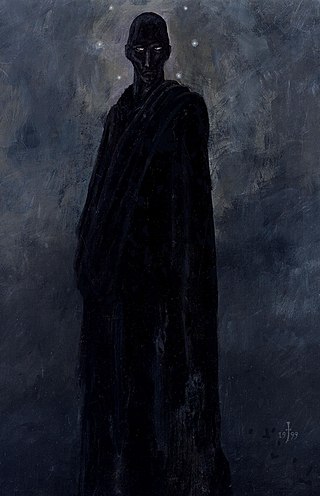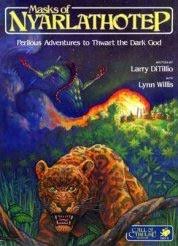
The Cthulhu Mythos is a mythopoeia and a shared fictional universe, originating in the works of American horror writer H. P. Lovecraft. The term was coined by August Derleth, a contemporary correspondent and protégé of Lovecraft, to identify the settings, tropes, and lore that were employed by Lovecraft and his literary successors. The name "Cthulhu" derives from the central creature in Lovecraft's seminal short story "The Call of Cthulhu", first published in the pulp magazine Weird Tales in 1928.

Cthulhu is a fictional cosmic entity created by writer H. P. Lovecraft. It was introduced in his short story "The Call of Cthulhu", published by the American pulp magazine Weird Tales in 1928. Considered a Great Old One within the pantheon of Lovecraftian cosmic entities, this creature has since been featured in numerous popular culture references. Lovecraft depicts it as a gigantic entity worshipped by cultists, in the shape of a green octopus, dragon, and a caricature of human form. The Lovecraft-inspired universe, the Cthulhu Mythos, where it exists with its fellow entities, is named after it.

Nyarlathotep is a fictional character created by H. P. Lovecraft. The character is a malign deity in the Cthulhu Mythos, a shared universe. First appearing in Lovecraft's 1920 prose poem "Nyarlathotep", he was later mentioned in other works by Lovecraft and by other writers. Later, writers describe him as one of the Outer Gods, an alien pantheon.

*Nodens or *Nodons is a Celtic healing god worshipped in Ancient Britain. Although no physical depiction of him has survived, votive plaques found in a shrine at Lydney Park (Gloucestershire) indicate his connection with dogs, a beast associated with healing symbolism in antiquity. The deity is known in only one other location, in Cockersand Moss (Lancashire). He was equated on most inscriptions with the Roman god Mars and associated in a curse with Silvanus. His name is cognate with that of later Celtic mythological figures, such as the Irish Nuada and the Welsh Nudd.

Azathoth is a deity in the Cthulhu Mythos and Dream Cycle stories of writer H. P. Lovecraft and other authors. He is the supreme deity of the Cthulu Mythos and the ruler of the Outer Gods, and may also be seen as a symbol for primordial chaos, therefore being the most powerful entity in the entirety of the Cthulhu Mythos.

The Dream-Quest of Unknown Kadath is a novella by American writer H. P. Lovecraft. Begun probably in the autumn of 1926, the draft was completed on January 22, 1927 and it remained unrevised and unpublished in his lifetime. It is both the longest of the stories that make up his Dream Cycle and the longest Lovecraft work to feature protagonist Randolph Carter. Along with his 1927 novel The Case of Charles Dexter Ward, it can be considered one of the significant achievements of that period of Lovecraft's writing. The Dream-Quest combines elements of horror and fantasy into an epic tale that illustrates the scope and wonder of humankind's ability to dream.
Titus Crow is the main character in the eponymous series of horror fiction books by Brian Lumley. The books are based on H. P. Lovecraft's Cthulhu Mythos.
The Hyperborean cycle is a series of short stories by Clark Ashton Smith that take place in the fictional prehistoric setting of Hyperborea. Smith's cycle takes cues from his friends, H. P. Lovecraft and Robert E. Howard and their works.

"The Haunter of the Dark" is a horror short story by American author H. P. Lovecraft, written between 5–9 November 1935 and published in the December 1936 edition of Weird Tales. It was the last written of the author's known works, and is part of the Cthulhu Mythos. The epigraph to the story is the second stanza of Lovecraft's 1917 poem "Nemesis".

The Whisperer in Darkness is a 26,000-word novella by American writer H. P. Lovecraft. Written February–September 1930, it was first published in Weird Tales, August 1931. Similar to The Colour Out of Space (1927), it is a blend of horror and science fiction. Although it makes numerous references to the Cthulhu Mythos, the story is not a central part of the mythos, but reflects a shift in Lovecraft's writing at this time towards science fiction. The story also introduces the Mi-Go, an extraterrestrial race of fungoid creatures.
Demonbane is a Japanese visual novel series by Nitroplus with mecha and Cthulhu Mythos elements. Beginning as an eroge visual novel for the PC, it was ported into a PlayStation 2 non-eroge remake, and spawned a sequel visual novel, a prequel novel, an anime television adaptation and a conversion to manga. An English version of the original Demonbane PC game was released by JAST USA. The anime is currently streamed with English subtitles by Crunchyroll.

The Lurker at the Threshold is a horror novel by American writer August Derleth, based on short fragments written by H. P. Lovecraft, who died in 1937, and published as a collaboration between the two authors. According to S. T. Joshi, of the novel's 50,000 words, 1,200 were written by Lovecraft.
"I, Cthulhu" is a short humorous story by fantasy author Neil Gaiman featuring H. P. Lovecraft's Cthulhu, who is dictating an autobiography to a human slave named Whateley. The story reveals much about Cthulhu's 'birth' and early life.

Cthulhu's Dark Cults is an anthology edited by David Conyers, containing ten Cthulhu Mythos short stories set in Chaosium's Call of Cthulhu role-playing game setting. All the stories take place during the 1920s and 1930s, the era in which the game is set.
American author H. P. Lovecraft (1890–1937) created a number of fictional deities throughout the course of his literary career. These entities are usually depicted as immensely powerful and utterly indifferent to humans, who can barely begin to comprehend them; however, some entities are worshipped by humans. These deities include the "Great Old Ones" and extraterrestrials, such as the "Elder Things", with sporadic references to other miscellaneous deities. The "Elder Gods" are a later creation of other prolific writers who expanded on Lovecraft's concepts, such as August Derleth, who was credited with formalizing the Cthulhu Mythos. Most of these deities were Lovecraft's original creations, but he also adapted words or concepts from earlier writers such as Ambrose Bierce, and later writers in turn used Lovecraft's concepts and expanded his fictional universe.

Masks of Nyarlathotep, subtitled Perilous Adventures to Thwart the Dark God, is an adventure campaign first published by Chaosium in 1984 for the second edition of the horror role-playing game Call of Cthulhu. A number of revised editions have subsequently been published. Masks of Nyarlathotep is a series of several sequential adventures set in the 1920s that take the player characters from New York, to London, Cairo, Nairobi, and Shanghai as they deal with the threat of the god Nyarlathotep. Screenwriter Larry DiTillio wrote the adventure with game designer Lynn Willis during a writer's strike. It received positive reviews in game periodicals including Casus Belli, The Space Gamer, White Dwarf, Different Worlds, and Dragon, and is considered to be one of the best roleplaying adventures of all time.









